Macro Quarterly Going global at peak US exceptionalism
The remarkable economic progress since the depths of the pandemic-induced recession has a catch: It’s no longer an early-cycle environment everywhere. We believe this means investors should adopt a more selective, discerning approach.

Evan Brown
Head of Macro Asset Allocation Strategy

Ryan Primmer
Head of Investment Solutions

Lucas Kawa
Asset Allocation Strategist
Highlights
Highlights
- Invest in regions where it’s still early cycle, like Europe and emerging markets: We believe that goods activity is strong globally and poised to stay so, with uneven vaccine access producing dispersion in service sector recoveries.
- US stimulus support appears to have peaked, and future policy actions are likely to include both higher spending and higher taxes. This reinforces our preference for procyclical, value, and international equities relative to broad equity beta.
- A tactical, temporary pause in the US Treasury selloff should catalyze a reversal of US dollar strength. Broadening economic momentum outside the US will likely sustain dollar softness.
- Emerging market currencies stand to benefit from fading headwinds and a turn in sentiment.
The remarkable economic progress since the depths of the pandemic-induced recession has a catch: It’s no longer an early-cycle environment everywhere. We believe this means investors should adopt a more selective, discerning approach towards how much risk they take, and where they take it.
The good news is that it’s still early cycle in much of the world outside the US. The lingering effects of COVID-19 and varied vaccine access are fostering dispersion in services sector performance. Meanwhile, global surveys of manufacturers indicate that activity is accelerating, new orders are firming, backlogs of work are elevated, and customer inventories are low: a recipe for robust future production. This combination bolsters the appeal of relative value procyclical positions compared to broad equity market beta.
From a top-down perspective, our high expectations for global growth justify a continued preference for equities over credit, and an underweight position in sovereign bonds. That being said, equity returns in 2021 have been front-loaded, in our view, particularly in the US. Stock price appreciation is likely to slow down as the year goes on.
We believe investors should overweight areas of the market levered to continued strength in global goods activity and which also have scope to positively surprise on services in the months ahead. This informs our preference for value stocks as well as ex-US developed market equities, and bearish stance on the US dollar, particularly versus European and high-beta emerging market currencies.
Peak policy support stateside
Peak policy support stateside
The USD 1.9 trillion round of US stimulus passed in March is the last iteration of purely stimulative, market-friendly pandemic relief we expect from Congress. Future measures probably will involve trade-offs – like physical infrastructure in tandem with corporate tax
increases. Such proposed policies would likely be more beneficial for the US economy and international equities than US stocks. Already, the effect of this stimulus on US growth is much more embedded in market expectations than its positive spillovers on activity abroad as US imports from the rest of the world accelerate, in our view.
Positive US data is no longer providing much of a boost to yields or the greenback. As such, we have renewed conviction on US dollar weakness, and take a more tactically neutral stance on US duration. Expectations for services sector normalization in the US are already lofty. This is evidenced by how much, and how soon, the market is pricing the Federal Reserve to lift interest rates.
Fed tightening is contingent on significant employment gains and sustained inflation. Services play an outsized role in both. We have much more faith in steady, sizeable employment gains than any persistent acceleration in price pressures beyond the telegraphed, base-effect driven jump in the second quarter.
Some of these hawkish expectations are poised to ebb over time as the central bank reaffirms its commitment to keeping rates on hold until the recovery is complete, even as economic data remains strong. This will reverse what has been a key positive impulse for the US dollar to date in 2021.
In US equities, we prefer an equal weight index vs. the S&P 500. Relative earnings growth favors more cyclically-oriented stocks, and the skew of policy risks – in particular taxes – pose potentially more acute headwinds to mega-cap technology stocks.
Nowhere to go but Europe
Nowhere to go but Europe
Per published reports, Europe is underperforming the US and UK on COVID-19 case levels and vaccinations. This dynamic is thoroughly understood and priced in by the market – so much so that recent news of renewed mobility restrictions did not spur any material underperformance of European assets.
Exhibit 1: Euro support coming from the turn in economic data
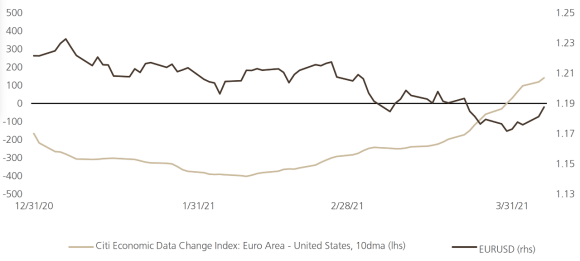
Exhibit 2: The good news is in the goods sectors
Percentage of 25 major countries with manufacturing PMIs both above 50 and above 3M ago level
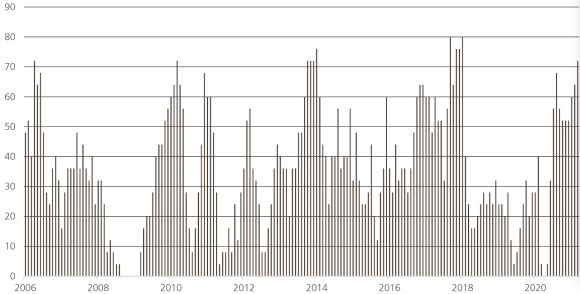
Pervasive pessimism means the bar is low to exceed expectations on vaccinations going forward. And during broad global growth inflection points, European equities have tended to post superior earnings growth than their US counterparts due to their more cyclical orientation. We prefer to zero in on cyclically-geared segments in this region, including European banks and Italian equities. European data are also evolving more favorably than in the US for the first time since the Georgia runoff elections, with the continent fueling recent improvement in global factory activity. These developments fortify our call that European currencies will advance relative to the US dollar. In the first quarter, the euro posted its largest advance vs. the safe haven Swiss franc since 2017. This was about changes in global investor risk appetite, as opposed to an improvement in the European Union’s economic fundamentals relative to Switzerland’s.
Exhibit 3: European profit growth outperformance on deck due to cyclical upswing
MSCI Europe less S&P 500 historical and expected earnings growth
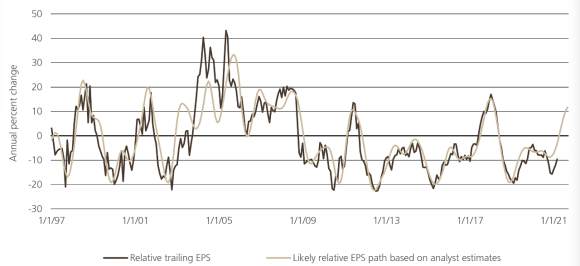
Exhibit 4: The foreign investor exodus of EM equities suggests pessimism is overdone
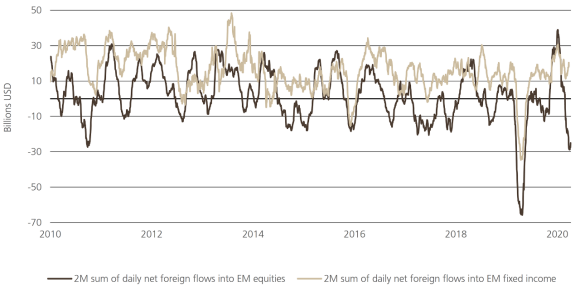
From anti-defensive to procyclical
From anti-defensive to procyclical
The most consistent market trend in the first quarter was the selloff in defensive assets such as US Treasuries, gold, and the aforementioned Swiss franc. In our view, hopes for a durable economic normalization will begin to be realized in the second quarter. This will allow investors to shift from a distaste for defensive assets, associated with diminishing left-tail risks, towards an embrace of the procyclical assets that are relative beneficiaries in a durable economic normalization.
In our view, emerging markets currencies are the most primed to outperform during this phase. The asset class has already weathered three negative catalysts this year: a US real rate shock, foreign investor outflows, and an idiosyncratic, severe drawdown in Türkiye.
All the while, EMFX has managed to largely hold support at the level it traded when the first vaccine announcement arrived in November. This was the crucial development that unlocked the vigorous global growth backdrop in place for 2021. Such an environment is generally positive for EM assets, even if in this instance these countries are not leading the upturn in global activity.
The Federal Reserve doesn’t want real rates too much higher in the front end of the curve, as evidenced by the median official rates projection staying on hold through 2023 even as growth projections were increased. The European Central Bank is signaling pushback against increases in nominal yields that are not matched by an improvement in the medium-term inflation outlook. Meanwhile, some emerging market central banks are already embarking upon a telegraphed withdrawal of accommodation to right-size policy amid the higher Treasury yield environment. These divergent positions may help restore some of the carry appeal of EMFX.
Very uneven vaccine access and COVID-19 outcomes across EM remain key risks to be monitored. These headwinds are sufficiently offset by the continued resilience in global activity, particularly in goods sectors, and the higher risk premium in EM relative to other cyclical assets. We favor the Russian ruble, Brazilian real, Mexican peso, and Polish zloty. Diversifying among EMFX is an important tactic to diminish the risk of any single country-specific vulnerability casting a pall on total performance.
Exhibit 5: EMFX moved into a higher trading range since the vaccine announcement
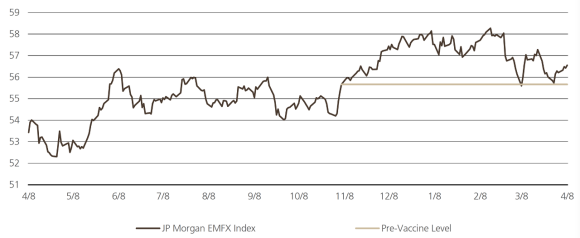
Risks to our view
Risks to our view
The overarching risk to our preferred positioning is that the market’s growth expectations prove overoptimistic.
We believe an abrupt withdrawal of policy support in China, perhaps exacerbated by a re-emergence of tensions with the new US administration, is the most plausible catalyst for a sustained reversal in procyclical positions across asset classes. This outcome is not our base case, but would likely see global duration rally and growth stocks outperform. Our short position in cyclical Asian currencies is therefore the most reliable, efficacious source of portfolio ballast to hedge against this risk, in our view.
A material retracement in US Treasury yields, rather than a tactical, measured pause in the sell-off, would also remove one element of cross-asset support for our relative value trades in equities. However, it is important to remember that the fundamental driver of value and international outperformance – superior earnings growth thanks to a robust economic recovery and more cyclical orientation – would continue to underpin this position.
Market participants may also begin to look ahead to 2022 and price in a substantial downshift in activity and earnings growth as economies pass peak policy support. This would also likely challenge our preferred trade set. However, we believe the magnitude of the stimulus already in the pipeline and the better starting point for household balance sheets entail that this expansion will age better than the recovery from the financial crisis. As such, it is too soon to call for a prolonged turn in this value over growth regime in equities given the likely economic momentum and lingering valuation gap.
Conclusion
Conclusion
We believe that vaccinations, coupled with economic resilience from China and accelerating activity in the US, are powerful catalysts that will lift all economic boats in the months ahead.
Relative value, rather than beta, is the most profitable way to position in this environment, based on the composition of global equity indexes and the nature of the most probable risks. Early cycle geographies where purchasing managers’ indexes are rising, operating margins are improving, and services sector activity is poised to inflect higher are preferred.
In our view, European and Japanese equities should outperform their US peers given their greater exposure to global growth and factory activity. The elevated risk premia available in emerging market currencies should compress as faith in the durability of the economic expansion swells. A tactical pause in the swift US Treasury selloff is likely to contribute to a fresh leg of softening in the US dollar. Over the medium term, we believe that the Treasury curve will resume its steepening trend. Solid global goods activity and more expansive rebound in service sectors across different countries may help make this retreat in the greenback more persistent.
The primary market themes of the first quarter were US economic outperformance and the shunning of traditionally defensive assets. We believe the next three months will be characterized by investors shifting towards geographies where the environment is still early cycle, and lingering pessimism lays the foundation for outsized returns on increased evidence of the broadening recovery.
Asset class attractiveness (ACA)
Asset class attractiveness (ACA)
The chart below shows the views of our Asset Allocation team on overall asset class attractiveness, as well as the relative attractiveness within equities, fixed income and currencies, as of 1 April 2021.
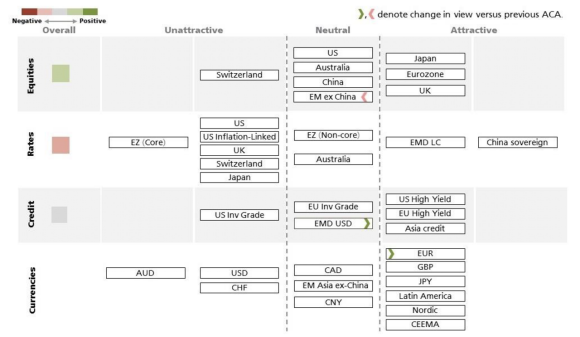

Asset Class | Asset Class | Overall signal | Overall signal | UBS Asset Management’s viewpoint | UBS Asset Management’s viewpoint |
|---|---|---|---|---|---|
Asset Class | Global Equities | Overall signal | Light green | UBS Asset Management’s viewpoint |
|
Asset Class | US Equities | Overall signal | Neutral | UBS Asset Management’s viewpoint |
|
Asset Class | Ex-US Developed market Equities | Overall signal | Light green | UBS Asset Management’s viewpoint |
|
Asset Class | Emerging Markets (EM) Equities(ex. China) | Overall signal | Neutral | UBS Asset Management’s viewpoint |
|
Asset Class | China Equities | Overall signal | Neutral | UBS Asset Management’s viewpoint |
|
Asset Class | Global Duration | Overall signal | Light red | UBS Asset Management’s viewpoint |
|
Asset Class | US Bonds | Overall signal | Light red | UBS Asset Management’s viewpoint |
|
Asset Class | Ex-US Developed-market Bonds | Overall signal | Light red | UBS Asset Management’s viewpoint |
|
Asset Class | US Investment Grade (IG) Corporate Debt | Overall signal | Light red | UBS Asset Management’s viewpoint |
|
Asset Class | US High Yield Bonds | Overall signal | Light green | UBS Asset Management’s viewpoint |
|
Asset Class | Emerging Markets Debt - US dollar / Local currency | Overall signal | Neutral / Light green | UBS Asset Management’s viewpoint |
|
Asset Class | Chinese Bonds | Overall signal | Dark green | UBS Asset Management’s viewpoint |
|
Asset Class | Currency | Overall signal |
| UBS Asset Management’s viewpoint |
|
A comprehensive solutions provider
A comprehensive solutions provider
UBS Asset Management Investment Solutions manages USD 124.2 billion (as of 30 September 2020). Our 100+ Investment Solutions professionals leverage the depth and breadth of UBS's global investment resources across regions and asset classes to develop solutions that are designed to meet client investment challenges. Investment Solutions' macro-economic and asset allocation views are developed with input from portfolio managers globally and across asset classes.
For more information, contact your UBS Asset Management representative or your financial advisor.
